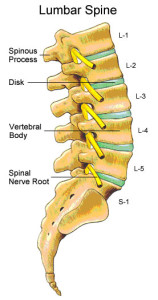 Compressing the lumbar spine
Compressing the lumbar spine
Compressing the lumbar spine all day long strikes me as an essence of the human condition.
I meet very few people with good posture and an overwhelming number with bad posture. This also seems to be part of the human condition.
We are, often maddeningly, creatures of habit, and there is nothing in particular that steers us towards positive behavior.
And we have an endless number of unconscious repetitive behaviors that are easily patterned in negative ways.
We simply walk, sit and stand the way we walk, sit and stand.
Unless for some reason over the course of our lives we have chosen to examine the behavior to try to change or improve it.
While I take for granted that a good number of people who follow my work have made that leap of introspection, the overwhelming majority of sentient beings have not.
Simply stated, most people are habitually compressing the lumbar spine whenever they walk and stand.
You might not think you lean back but look sideways in a mirror. Or have someone take a picture of you from the side.
We tend to lean backward habitually and since no one is telling us not to, we keep doing it.
In fact, we are encouraged to do it with the world’s worst instruction: “Stand up straight and take your shoulders back.”
When we stand poorly over the course of a lifetime this often gentle compression can easily allow the spine to degenerate.
And the gentle part makes it all the more insidious.
Just to be clear, sitting creates misery of a different sort.
Don’t lean backward!
The lower back or lumbar spine is made up of five bones that are referred to as L1-5 with the uppermost one labeled L1.
The lumbar bones are different from the other bones of the spine. They are designed for bearing and transferring weight exclusively.
To that end they are the largest bones of the spine and while they can flex and extend they have very little ability to twist.
Additionally, the spine can be divided into front and back sections. The front is the big bones with cushiony discs between them.
The back half of the spine is where movement is generated.
This back half is made up of bony projections called processes. There are transverse processes on either side. And one that points to the back is called the spinous process.
You should be able to see the space between the spinous processes of the lumbar spine in the pictures. These spaces allow for flexing and extending the spine.
The goal over the course of our lives is to maintain the space between the spinous processes with good posture and movement patterns.
But, as I said, most people are leaning slightly backward all the time.
And the empirical evidence is the overwhelming number of spines that degenerate and undergo surgery.
These spines that degenerate often follow a similar pattern when walking and standing.
Leaning slightly backward, minimizing the distance between the spinous processes, and essentially compressing the lumbar spine all the time.
Compressing the lumbar spine is nothing more than an ingrained habit and with repetition, habits can change.


